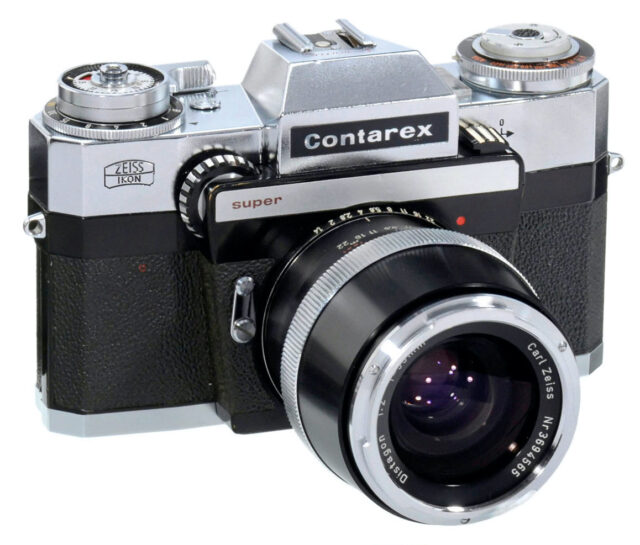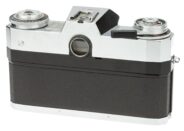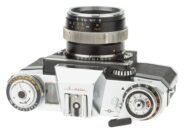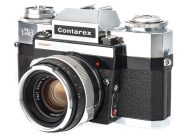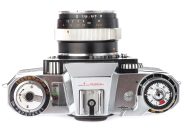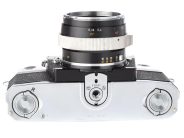Announced
Production status
System
Zeiss Ikon Contarex super
35mm MF film SLR camera • Discontinued
Specification
| Format: | |
| 35mm full frame | |
Film type: | 135 cartridge-loaded film |
| Contarex [46mm] | |
| Shutter: | |
Type: | Focal-plane |
Model: | Mechanical |
Speeds: | 1 - 1/1000 + B |
| Exposure: | |
Exposure metering: | Through-the-lens (TTL), open-aperture |
Exposure modes: | Aperture-priority Auto |
| Shutter-priority Auto | |
| Manual | |
| Physical characteristics: | |
Weight: | <No data> |
Dimensions: | <No data> |
Manufacturer description #1
The new CONTAREX S has been christened "Super" because of its remarkable improvements. It is equipped with a newly designed CdS exposure meter system that gives focus-true light measurement in the path of the rays of all interchangeable lenses. It is an ideal camera for hobbyists and pros.
All CONTAREX models have one thing in common: their optical equipment is of outstanding quality with regard to both imaging efficiency and the broad range of applications. 18 ZEISS interchangeable lenses are available with angles of field from 100 deg. to 2.5 deg. In every respect the CONTAREX system is precision engineered right down to the last detail and satisfies every requirement for top-flight photographic performance. It is the result of joint research, manufacture and development by ZEISS IKON - VOIGTLANDER, whose products are known throughout the world for their dependability. In addition, ZEISS IKON - VOIGTLANDER offers a world-wide guarantee, an invaluable service spanning countries and continents.
***
Single-lens reflex camera, 24x36 mm, CdS exposure meter in ray path of interchangeable lenses, cross-coupled with diaphragm and shutter speed setting mechanism, narrow-field measurement permits "spot" metering of portions of picture, pointer visible in the viewfinder and on the camera body, extreme range of measurement (for 100 ASA/21 DIN and f/1.4, up to 1 sec.). Film speeds from 6 to 1600 ASA or 9 to 33 DIN, command panel in the reflex finder shows all settings. Focal-plane shutter, quick-change bayonet fitting and all the other fine features as in the CONTAREX P.
Manufacturer description #2
The Contarex S is a new 35 mm, semi-automatic addition to the famed Contarex series featuring unique CdS metering behind-the-lens that gives combined advantages of spot and integrated readings. Every operational controls is visible in the viewfinder. It accepts all the elements made since the first Contarex model in conjunction with new optical and mechanical innovations.
***
Focal-plane shutter 1sec. - 1/1000 sec. plus B. CdS meter reading approx. 7 deg. behind mirror into cell located at bottom of camera body (most trouble free, sturdy design) is very sensitive, covering all shutter speeds and apertures over an ASA range from 10-3600. Lock-up mirror for use with ultrawide 21 mm Biogon. On and off switch for meter, delayed action, hot shoe flash plus synchro socket with locking device. Lenses from 18-1000 mm plus Vario Sonnar 40-120 mm, 85-250 mm, also available: 50 and 35 mm lenses with automatic flash control. Shutter speeds and aperture are visible in viewfinder and top cover for easy alignment. Battery tester, rewind crank and interchangeable film backs.
Manufacturer description #3
Contarex Super
the superlative slr system... from ziv
Contarex Super is the latest version of the famed Contarex series. It features the radically new behind-the-lens CdS exposure meter that gives combined advantages of spot and integrated readings. Every operational control is visible in the viewfinder, including cross coupled aperture/speed exposure choice.
A choice of viewfinder screens, film magazine backs and an ultra wide range of interchangeable lenses from 18mm to 1000mm are available. The Contarex S has an inordinate number of attachments designed for every requirement of aesthetic and scientific photography.
With the critical Zeiss Tessar f/2.8, 50mm lens... $534.00
specifications
The Contarex Super represents one of the most highly sophisticated single lens reflex camera systems. Among its outstanding features is the CdS exposure meter which measures behind-the-lens through the instant return mirror providing for the combined advantages of spot and integrated readings even in light levels as low as .8 asb. Focal plane shutter with speeds from 1 to 1/1000 second plus B. Aperture and speed controls are cross coupled to the light meter system and are visible in the viewfinder for adjusting ease during shooting. The range for the exposure meter is from 6 to 1600 ASA. Choice of interchangeable focusing screens, full ground glass, fresnel-type with split image, or clear glass with cross hairs.
Swift motion film advance lever on top of camera, frame counter, cordless hot shoe, flash contact, special PC outlet with safety switch and lock, interchangeable magazine backs, provision for data recording on film, battery tester, and many other features make the Contarex Super an exceptional instrument of versatility.
Finally, the superb availability of interchangeable lenses, including all previous Contarex models (except Biogon f/4.5, 21mm) and the latest innovation... the 18mm Distagon f/4 with 100° wide angle. The Planar f/2, 50mm and the Distagon f/4, 135mm, are both synchronized for flash automation.
All lenses have quick-change bayonet fittings that focus down to very short distances. Supplementary lenses, bellow extensions, and micro adapter cover the full range of macrophotography and photomicrography.
From the editor
The "professional" and "super" designs were begun at the same time but, with the constantly changing world of built-in exposure meters, the design and development of the "super" took longer and the camera came out nearly a year after the "professional". It offered no major improvements other than the through-the-lens CdS meter, but it was a definite improvement over the "Bullseye" in both styling and handling. Shutter speeds and aperture settings were visible in the viewfinder and the meter was designed to be a match-needle system.
